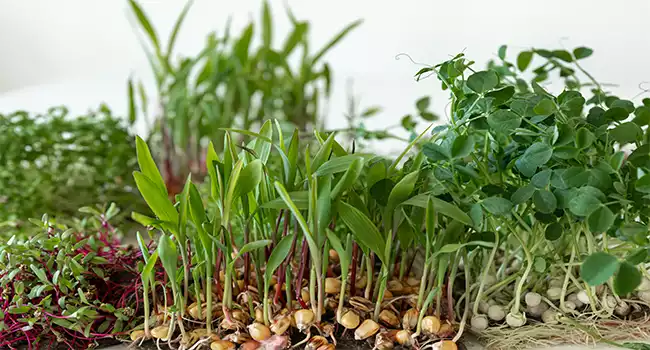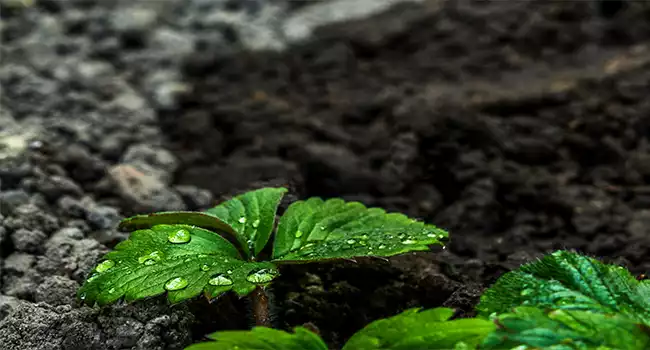Humic acid, a complex organic compound formed over millennia from decomposed plant and animal matter, is revolutionizing gardening and agriculture. Backed by scientific research and embraced by experts, this natural soil amendment unlocks a myriad of benefits for soil health, plant growth, and sustainable cultivation. Whether you’re a seasoned gardener or a novice plant enthusiast, understanding and utilizing humic acid can transform your gardening experience.
What is Humic Acid? Unveiling the Gardener’s Secret Weapon
Humic acid is a key component of humus, the dark, fertile organic matter that gives soil its richness and life-giving properties. It’s a complex blend of carbon-based compounds, including fulvic acid and humin, each contributing unique benefits that enhance plant growth and soil fertility.
Humic acid is not a fertilizer in the traditional sense. Instead, it acts as a soil conditioner, improving the soil’s physical, chemical, and biological properties to create an optimal environment for plant roots and beneficial microorganisms.

10 Science-Backed Humic Acid Benefits
- Revitalizing Soil Structure: Humic acid improves soil tilth, aeration, and drainage, transforming compacted or clay-heavy soils into thriving ecosystems for plant roots. This enhanced soil structure promotes better water infiltration and root penetration, leading to healthier and more vigorous plants.
- Maximizing Nutrient Availability: Humic acid acts as a natural chelator, binding essential nutrients and trace minerals like iron, zinc, and manganese, making them readily available for plant uptake. This not only improves nutrient efficiency but also reduces the need for synthetic fertilizers.
- Nourishing the Soil Microbiome: Humic acid fuels the growth and activity of beneficial soil microorganisms such as bacteria and fungi. These microbes play a crucial role in nutrient cycling, decomposition of organic matter, and disease suppression, contributing to a healthy and balanced soil ecosystem.
- Increasing Plant Growth and Yields: Numerous scientific studies have documented humic acid’s ability to increase crop yields across various plant species. By promoting root development and nutrient uptake, it enhances plant vigor, flowering, and fruit production. Research published in the Journal of Plant Nutrition and Soil Science has shown significant yield increases in tomatoes, peppers, and other crops treated with humic acid.
- Building a Stronger Defense System: Plants treated with humic acid exhibit increased resistance to pests, diseases, and environmental stressors like drought, heat, and frost. This natural defense mechanism, attributed to the stimulation of plant immune responses, can reduce the need for chemical pesticides and fungicides.
- Detoxifying Contaminated Soil: Humic acid’s unique ability to bind with heavy metals and pesticides makes it a powerful tool for remediating polluted soils. By immobilizing these toxins, humic acid prevents their uptake by plants, making the soil safer and healthier for both plants and people.
- Encouraging Robust Root Growth: Strong, healthy roots are essential for plant survival and productivity. Humic acid stimulates root growth by promoting cell division and elongation, leading to better nutrient and water absorption and ultimately resulting in more resilient and productive plants.
- Improving Water Retention: Humic acid enhances soil’s ability to hold moisture by increasing its water-holding capacity. This is achieved through improved soil structure and the formation of aggregates that trap water. This benefit is especially crucial in arid climates or regions prone to drought.
- Reducing Fertilizer Dependency: By optimizing nutrient availability and soil health, humic acid can help reduce reliance on synthetic fertilizers. This not only saves money but also contributes to sustainable agriculture practices and healthier ecosystems.
- Boosting Seed Germination and Early Growth: Humic acid has been shown to enhance seed germination rates and seedling vigor. It can improve seed imbibition (water uptake) and stimulate enzyme activity, leading to faster and more uniform germination.

Choosing the Right Humic Acid Product
Humic acid is available in various forms, each with its unique advantages and ideal applications:
1- Liquid Humic Acid
This form is easily absorbed by plants and can be applied as a foliar spray or through irrigation systems.
Best for: Quick nutrient boosts, stressed plants, specific plant targeting, and hydroponic systems.
2- Granular Humic Acid
Best suited for soil application, granular humic acid releases nutrients gradually over time, improving soil structure and fertility.
Best for: Improving soil structure, enhancing water retention, vegetable gardens, lawns, and long-term soil health.
3- Humic Acid Concentrate
These highly concentrated forms are often diluted before use and offer flexibility in application methods.
Best for: Experienced gardeners who want customizable application rates and versatile use in both foliar sprays and soil drenching.
How to Use Humic Acid
Humic acid’s versatility allows for various application methods, each with its own advantages:
- Soil Application: Incorporate granular humic acid into the soil before planting or as a top dressing around existing plants. Liquid humic acid concentrate can be diluted and applied as a soil drench.
- Foliar Application: Spray diluted liquid humic acid directly onto plant leaves, ideally in the early morning or late evening to avoid sunscald.
- Hydroponics: Add diluted liquid humic acid to your hydroponic nutrient solution.
- Seed Treatment: Soak seeds in a diluted humic acid solution before planting.
Dosage and Frequency:
- Always follow the instructions on the specific humic acid product you are using.
- General guidelines for liquid humic acid suggest using 1-3 gallons per acre or 1-2 tablespoons per gallon of water for smaller applications.
- Granular humic acid is typically applied at a rate of 1-2 pounds per 100 square feet.
Expert Tip: Consider conducting a soil test before applying humic acid to determine your soil’s specific needs and adjust the dosage accordingly.
Expert Insights on Humic Acid
Humic acid is a game-changer in sustainable agriculture. Its ability to improve soil health, enhance nutrient uptake, and boost plant resilience makes it an invaluable tool for farmers and gardeners alike.

FAQ
What is the difference between humic acid and fulvic acid?
Fulvic acid is a smaller component of humic acid, known for its high solubility and ability to transport nutrients directly into plant cells. Both offer benefits for plants and soil.
Can I use humic acid with other fertilizers?
Absolutely! Humic acid complements other fertilizers, including organic options, by improving their effectiveness and enhancing nutrient uptake.
Is humic acid safe for organic gardening?
Yes, when sourced from reputable suppliers, humic acid is a natural soil amendment approved for organic use. Look for OMRI (Organic Materials Review Institute) certified products for peace of mind.
How often should I apply humic acid?
Application frequency depends on the product type and your specific needs. Granular forms can be applied annually, while liquid humic acid may be used more frequently. Always follow product recommendations and consider soil testing for optimal results.
What are humic substances?
Humic substances are complex organic substances found in soil organic matter, peat, and coal. They are formed through the decomposition of plant and animal residues. The two main components of humic substances are humic acid and fulvic acid.
What are the benefits of using humic acid products in agriculture?
Humic acid products offer numerous benefits for plant health and soil quality:
- Enhanced nutrient absorption: Humic acid improves the availability and uptake of essential soil nutrients by plants.
- Stimulated microbial activity: Humic acid acts as a food source for beneficial microbes in the soil, increasing microbial activity and promoting a healthy soil ecosystem.
- Improved soil structure: Humic acid molecules bind soil particles together, improving soil structure, aeration, and water-holding capacity.
- Increased root growth: Humic acid stimulates root growth, leading to stronger and healthier plants with better access to water and nutrients.
- Reduced fertilizer requirements: Humic acid improves nutrient efficiency, potentially reducing the need for chemical fertilizers.
- Enhanced stress tolerance: Humic acid helps plants better withstand environmental stresses like drought, salinity, and extreme temperatures.
- Increased crop yields: By improving soil fertility and plant health, humic acid can contribute to increased crop yields and quality.
How does humic acid improve nutrient absorption?
Humic acid molecules can chelate or bind with essential trace elements like iron, zinc, and manganese, making them more available for plant uptake. Humic acid also stimulates root development and increases the permeability of plant cell membranes, facilitating nutrient absorption.
How does humic acid benefit soil microbes?
Humic acid acts as a food source and energy booster for soil microbes, promoting their growth and activity. A thriving microbial population helps decompose organic matter, cycle nutrients, and suppress soil-borne diseases, contributing to a healthy and fertile soil environment.
How can I apply humic acid to my plants?
Humic acid application can be done through various methods, including:
- Soil drench: Dilute humic acid products in water and apply them directly to the soil around the base of plants.
- Foliar spray: Mix humic acid with water and spray it on the leaves of plants for direct absorption.
- Seed treatment: Soak seeds in a humic acid solution before planting to enhance germination and seedling vigor.
- Fertilizer additive: Combine humic acid with your regular organic fertilizer to boost its effectiveness.
Are humic acid products safe for the environment?
Humic acid is a natural organic substance derived from soil organic matter. Humic acid products are generally considered safe for the environment when used according to recommended guidelines. However, it’s always essential to follow product labels and safety instructions.
Conclusion
Humic acid is more than just a soil amendment; it’s a catalyst for creating a vibrant, flourishing garden ecosystem. From revitalizing depleted soil and maximizing nutrient availability to fortifying plants against environmental stressors and boosting yields, humic acid’s benefits are undeniable and backed by scientific research.
By incorporating humic acid into your gardening practices, you’re not merely feeding your plants; you’re investing in the long-term health and vitality of your soil, creating a sustainable foundation for generations of abundant harvests and vibrant blooms. Whether you’re cultivating a vegetable garden, nurturing a lush lawn, or tending to delicate flowers, humic acid can unlock your garden’s full potential.
Don’t wait – give your garden the gift of humic acid today and experience the transformative power of this natural wonder. Your plants will thank you with robust growth, vibrant colors, and bountiful yields, while you enjoy the satisfaction of nurturing a truly thriving and sustainable garden ecosystem.

